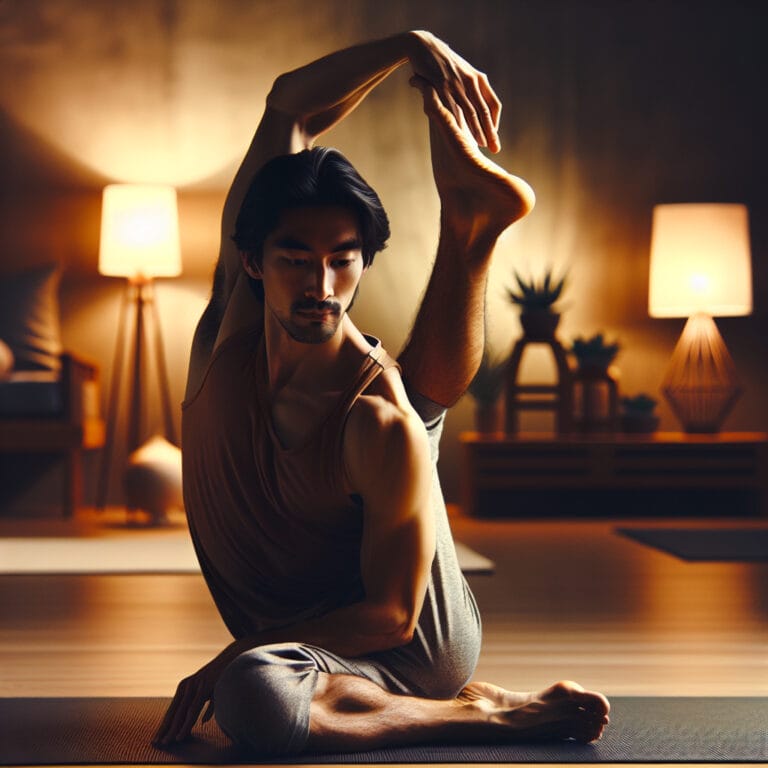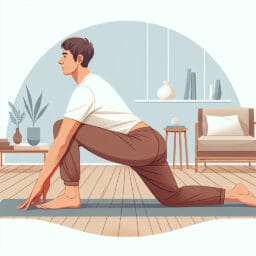
Effective Yoga Poses for Sciatica Relief: A Comprehensive Guide
Table of Contents
- Introduction: The Role of Yoga in Managing Sciatica
- Understanding Sciatica: Causes and Symptoms
- The Benefits of Yoga for Sciatica
- Precautions to Take When Practicing Yoga with Sciatica
- Top Yoga Poses for Sciatica Relief
- Conclusion: The Importance of Consistent Yoga Practice for Sciatica Relief
- References
- Frequently Asked Questions
Introduction: The Role of Yoga in Managing Sciatica
A surprising statistic reveals that around 40% of people will experience sciatica pain in their lifetime. This discomfort caused by the irritation or compression of the sciatic nerve often begins as a sharp throbbing in the lower back, extending down through the hips and buttocks, and can even affect the legs. The burning sensation or chronic low back pain associated with sciatica can be debilitating for many, disrupting their daily activities. However, science points to an ancient practice that may provide relief – yoga. A dedicated yoga practice offers several benefits for individuals grappling with sciatica; providing not just temporary relief but also strengthening the body against future flare-ups.
Yoga helps manage this type of neuropathic pain by gently stretching and strengthening targeted areas like lumbar spine, hips back, and glutes along with supporting muscles in your lower back and legs which play a crucial role in your overall spinal health. Different types of yoga poses such as Downward-Facing Dog or Cobra pose provide gentle pressure on these key areas to stimulate blood flow and ease tension off compressed nerves resulting in reduced inflammation.
It’s important to note that although specific poses focus on your lower back and hip regions – home to the piriformis muscle often implicated in sciatica – it’s truly a whole-body approach aimed at improving posture, alignment while increasing flexibility throughout your entire body. Such holistic method strengthens not just affected parts but fortifies surrounding structures too thus bringing balance in body mechanics which is vital for maintaining nerve health.
In our upcoming sections we’ll explore some beneficial yoga poses designed specifically for easing sciatica pain including how they should be safely practiced to avoid further nerve damage or severe pain episodes during physical therapy program which includes yoga routines.
Understanding Sciatica: Causes and Symptoms
While the sharp throbbing of sciatica pain can be daunting, understanding this condition can pave the way for effective management strategies. Sciatica is a symptom of an underlying problem in the lower back or hip, often caused by a herniated disc or bone spur pressing on parts of the sciatic nerve. This large nerve extends from your lower back down through your hips and buttocks into each leg; irritation or compression anywhere along this path may ignite that familiar burning sensation known as sciatic pain.
An inciting factor could be as simple as poor posture, so it’s crucial to consider our daily habits. Sitting for prolonged periods at a desk or driving extensively can create undue pressure on our lumbar spine, contributing to complications like chronic low back pain and even sciatica. Moreover, conditions like piriformis syndrome—wherein the piriformis muscle spasms and irritates the nearby sciatic nerve—can also lead to debilitating discomfort.
Symptomatically, each individual’s experience with sciatica may vary but some common manifestations include an intense pain in one side of your lower body (often starting from your lower back and traveling down one leg), numbness in legs or feet, tingling sensation akin to pins-and-needles running down your leg, weakness when moving the affected limb and sometimes even loss of bladder control in severe cases.
Here’s where yoga steps in with its vast repertoire of poses targeting various muscles groups; it provides gentle stretches aimed at easing tension off these compressed nerves while strengthening supporting structures around them for long-term relief. For instance, Downward-Facing Dog acts upon multiple areas including backs of legs (glutes), arms alongside torso which helps stretch lift spine relieving pressure off compressed nerves. Simultaneously Cobra Pose helps strengthen lower back muscles thereby improving overall spinal health over time.
As we journey further into this blog post let us delve deeper into how specific types yoga poses play pivotal roles in managing this nerve condition and what precautions one must adhere to while practicing yoga with sciatica.
| Sciatica: Causes and Symptoms | |
|---|---|
Causes
| Symptoms
|
Yoga Poses for Relief
| |
| Precautions Adhere to specific precautions while practicing yoga with sciatica. | |
The Benefits of Yoga for Sciatica
It’s clear that yoga has a pivotal role in managing the sharp throbbing and burning sensation characteristic of sciatica pain. As you learn to navigate this neuropathic condition, integrating specific yoga poses into your physical therapy program could be a game-changer. Considering the anatomy involved, the sciatic nerve runs from our lower back down through our hips and legs. When irritation or compression occurs, typically due to herniated disc or piriformis muscle issues, we experience the dreaded sciatica pain.
A strategic selection of yoga poses can provide targeted relief by stretching and strengthening key areas like our lumbar spine, hips back, as well as the supporting muscles in our lower back and legs – effectively easing tension off the compressed nerves and stimulating improved blood flow. Poses such as Downward-Facing Dog with its focus on arms alongside torso work to stretch and lift the spine thus relieving pain while Cobra pose fortifies lower back muscles enhancing overall spinal health.
And let’s not forget about Pigeon Pose; known for its benefit on hip flexibility – vital when dealing with sciatic pain given how closely connected hip stability is to maintaining nerve health. However, it’s worth noting here that like any physical exercise regimen caution must be exercised especially if you feel pain during certain poses or have a history of severe nerve damage.
Scientific research supports these claims too! A study published in Pain Medicine found individuals with chronic low back pain who engaged in therapeutic yoga exercises had significantly less disability and depression compared to those which only followed standard medical care protocols.
While incorporating these type yoga poses consistently may seem daunting initially remember every journey begins with one step – or rather one breath! Start by setting small feasible targets such as holding each pose for ten breaths at a time allowing your body time to adjust gradually without any undue strain on your left leg or left hand if you already struggle with controlling movements due to tingling sensations associated with this condition.
Ultimately, consistent yoga practice holds promise in not just offering sciatica relief but also fortifying your body against future flare-ups. By understanding the connection between posture, alignment and nerve health you’ll be well-equipped to manage and limit this condition’s impact on your life.
Precautions to Take When Practicing Yoga with Sciatica
In the quest to ease sciatica pain, yoga emerges as a gentle yet effective weapon. But like any physical activity, it’s crucial to approach it with caution to avoid exacerbating symptoms or causing further nerve damage. Lower back care should be at the forefront of your practice and one way is by ensuring proper alignment during poses – especially those targeting the lumbar spine and hips back area which are directly linked to sciatic nerves. For example, in Downward-Facing Dog, strive for a straight line from wrists through upper arms up to your hips; palms facing down while maintaining knees bent can reduce strain on your lower back.
Modifying yoga poses according to personal comfort levels is another safety measure worth taking note of. If you feel sharp throbbing or a burning sensation during certain positions, listen to your body’s signals – don’t push into severe pain territory. Instead opt for modifications such as using props like a folded blanket under your left knee during Pigeon Pose or keeping legs straight instead of bending them in Cobra pose thus putting less pressure on inflamed sciatic nerves running down left leg.
Furthermore, remember that transitions between poses matter too. When moving from one pose to another ensure feet remain flat on ground supporting weight evenly rather than tilting towards either side which may cause unnecessary stress on left hip potentially igniting tingling sensations associated with this condition.
Breathing deeply throughout Yoga sessions also plays an essential role; aim for ten breaths per pose letting each inhale lift you slightly and each exhale help deepen stretch without undue strain; after all yoga is about harmonizing mind body connection through breath control contributing significantly towards chronic low back pain relief.
Finally consider integrating regular consultations with physical therapy professionals into routine who can guide personalized program that includes specific type yoga poses best suited for managing existing level of disc herniation if any alongside aiding preventive measures against future flare-ups thereof enhancing overall spinal health over time while gradually building strength and flexibility in your entire body.
So embark on this journey towards sciatica relief with a mindful approach respecting body’s signals, modifying poses when necessary while maintaining focus on breath control – because the power to manage your back pain is literally in your hands… and feet… and breath!
Top Yoga Poses for Sciatica Relief
A surprising fact about yoga for sciatica pain management is the transformative role of Child’s Pose. This deceptively simple pose carries an arsenal of benefits targeting the lower back, a region often plagued by chronic low back pain in those grappling with sciatica. The act of folding forward allows your lumbar spine to stretch and relax while taking pressure off the sciatic nerves. To perform Child’s Pose, start on your knees, bring your bottom down to rest on your heels and extend your arms alongside your body with palms facing up. Slowly bend forward till you can rest your forehead on the mat; stay here for around ten breaths allowing each inhale to fill your back and every exhale releasing any tension.
Next in our pose library is Pigeon Pose – renowned in yoga practice for its profound impact on hip flexibility which directly aids in easing sciatic discomfort originating from left hip or piriformis muscle issues. Begin in Downward-Facing Dog then draw one leg underneath you placing it as if sitting cross-legged while extending other leg straight behind; lower yourself onto a folded blanket if needed reducing strain on left knee. Breathe deeply for ten breaths feeling a gentle stretch along left thigh and hips back area.
Cobra pose offers distinct benefits such as strengthening important muscles supporting our spine thus aiding chronic low back pain relief. Lying flat belly-down, position hands under shoulders palms facing down; slowly lift upper body while keeping hips, legs glutes grounded – much like a cobra rising! Hold this pose letting each breath deepen stretch lifting heart towards sky thereby putting less pressure on inflamed lower side potentially limiting future nerve damage risk.
Seated Forward Bend presents another effective weapon against sharp throbbing associated with sciatica. Sitting upright with legs straight extended before you, reach tall through crown head stretching spine; hinge at hips leaning torso over thighs aiming to hold onto feet but remember not force anything that causes severe pain. This pose aims to stretch lift lower back and hamstrings which coupled with ten breaths could effectively ease sciatica pain.
Lastly, Reclining Hand-to-Big-Toe Pose provides targeted relief for leg discomfort due to sciatic nerve issues. Lying flat on your back, use a yoga strap or towel looped around one foot while keeping the other leg straight; gently pull lifted foot towards body till you feel comfortable stretch along back of extended leg. Remember each exhale should deepen stretch not force it causing more harm than good!
These type yoga poses integrate seamlessly into any physical therapy program that includes yoga routines customised for individuals learning about how yoga manages sciatica pain – offering a promising path towards lasting sciatica relief without overlooking potential risk of increased nerve damage if poses are performed incorrectly or pushed beyond comfort zone. Thus, whether it’s the stretching in Child’s Pose or strength-building Cobra pose, striking a balance between effort and ease is crucial in this journey towards managing your back pain through an effective and mindful yoga practice.
Conclusion: The Importance of Consistent Yoga Practice for Sciatica Relief
Delving into the mystical realm of yoga reveals a treasure trove of poses, each designed meticulously to work on specific areas of our body. Quite remarkably, many such poses offer significant relief from sciatica pain; that sharp throbbing and burning sensation initiated by an inflamed sciatic nerve. The secret lies in yoga’s ability to harmoniously stretch and strengthen muscles surrounding the troubled nerves, especially those straddling our lower back and hips area. For instance, striking the Downward-Facing Dog or Cobra pose not only stirs a soothing sense of calm but subtly works on your lumbar spine and back muscles, mitigating strain on these vital structures.
Yet it’s crucial to note that while yoga offers promising results for sciatica relief, it is not an instant fix but rather involves gradual progress through consistent practice. As you journey with patience, steering through each pose mindfully – your left knee gently bent in Pigeon Pose or palms facing down in Downward-Facing Dog – imagine channeling healing energy to your left hip or left thigh which often bears the brunt of sciatic pain. Remember as you breathe deeply during each pose – say ten breaths per pose – you aren’t just enhancing flexibility but also fortifying your entire body against future potential flare-ups.
Indeed embracing yoga as part of a comprehensive physical therapy program has transformative effects: easing chronic low back pain; reducing episodes of severe pain; improving overall spinal health thereby limiting nerve damage risk besides fostering general well-being transcending beyond physical benefits into emotional resilience too. As we continue exploring more about how yoga manages sciatica pain remember this ancient discipline does more than just put us at ease – it empowers us to reclaim control over our health one breath at a time!
References
Many are unaware that yoga holds a secret repertoire of poses uniquely tailored to target the lower back area, playing a pivotal role in managing sciatica pain. Each pose subtly yet effectively stretches and strengthens the muscles surrounding the troubled sciatic nerves. The Downward-Facing Dog, for example, works wonders on your lumbar spine and back muscles, taking off undue strain with each breath you take. It’s not just about easing chronic low back pain though; yoga emboldens you to fortify your body against future occurrences. Through mindful practice, including ten breaths per pose and respecting signals from your body – like a tingling sensation or sharp throbbing in your left leg – yoga encourages an intimate understanding of your own physique. Feel empowered as you transfer healing energy towards areas like the left hip or piriformis muscle which often bear the brunt of sciatic pain. Remember, Rome wasn’t built in a day – so too with reaping yoga’s benefits for sciatica relief; it demands consistency and patience but promises holistic well-being that transcends beyond physical health into emotional resilience too!



